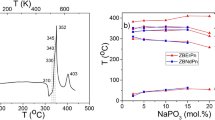Abstract
The theory and practice of oxynitride glass synthesis and property evaluation came into effect since late 70’s. Its importance lies in the fact of its formation at the grain-boundary of synthesized silicon-nitride ceramics with additives. Earlier, heating an oxide glass with NH3 and/or N2 was the route to obtain oxynitride glass. Later on greater amount of nitrogen retention was made possible using AlN or Si3N4 as batch material. Silicate, borate and phosphate systems were studied in isolation or in conjugation. Melting temperature of such glasses varied from 1500–1800° C. Different technological developments regarding furnace atmosphere, temperature, compositions etc have been discussed towards a successful synthesis with a thermodynamic approach. Nitrogen content in glass as high as 36.8 eq% has been reported by the application of an overpressure of 30 atm N2. Different physical and chemical properties have been discussed in relation to nitrogen content in glass. Structural aspects have been considered with respect to XPS and IR spectroscopic studies. Finally some points have been highlighted towards some potential applications
Similar content being viewed by others
References
Bagaasen I M and Risbud S H 1983J. Am. Ceram. Soc. 66 69
Baik S and Raj R 1985J. Am. Ceram. Soc. 68 C168
Brinker C J, Haaland D M and Loehman R E 1983J. Non-Cryst. Solids 56 179
Brow Richard, Pantano K and Carlo G 1984J. Am. Ceram. Soc. 67 C72
Budov V V, Bormotunov K A, Sarkisov P D and Medvedev V V 1996Glass Phys. Chem. 22 378
Coon D N, Doyle T E and Weidner J R 1989J. Non-Cryst. Solids 108 180
Coon D N, Rapp J C, Bradt R C and Pantano C G J R 1983J. Non-Cryst. Solids 56 161
Das T 1993Diffusion of sodium and iron in oxynitride glasses, Ph.D. Thesis, Jadavpur University, Jadavpur
Das T, Sanyal A S and Mukerji J 1991Phys. Chem. Glasses 32 180
Das T, Sanyal A S and Mukerji J 1994Phys. Chem. Glasses 35 198
Davies M W and Meherahli S G 1971Metall. Trans. 2 2729
Day D E 1989J. Non-Cryst. Solids 112 7
Elmer T H and Nordberg M F 1967J. Am. Ceram. Soc. 50 275
Frischat G H, Krause W and Hubenthal H 1984J. Am. Ceram. Soc. 67 C10
Frischat G H, Krause W and Sebastian K 1985J. Am. Ceram. Soc. 68 C305
Grande T, Jacob S, Holloway J R, Mcmillan P F and Angll C A 1995J. Non-Cryst. Solids 184 151
Jack K H 1977Nitrogen ceramics (ed.) F L Riley (Leyden: Noordhoff)109 262
Jankowski P E and Risbud S H 1980J. Am. Ceram. Soc. 63 350
Jankowski P E and Risbud S H 1983J. Mater. Sci. 18 2087
Konderatowicz J and Wasylak J 1995Proc. 17th int. cong. on glass 5 p. 540
Larson R W and Day D E 1986J. Non-Cryst. Solids 88 97
Larson S C and Frischat G H 1998Glastech. Ber. 71 19
Loehman R E 1979J. Am. Ceram. Soc. 62 491
Loehman R E 1980J. Non-Cryst. Solids 42 433
Loehman R E 1985Treatise on materials science and technology (Acad. Press Inc)26 p. 119
Luping Yao and Quanxin Fang 1983J. Non-Cryst. Solids 56 167
Makishima A, Mitomo M, Ii N and Tsutsumi M 1983J. Non-Cryst. Solids 66 C55
Marchand R 1982CR Acad. Sci. Paris 294 91
Marchand R 1983J. Non-Cryst. Solids 56 173
Mc Millan P F, Sato R K and Poe B T 1998J. Non-Cryst. Solids 224 267
Messier D R and Deguire E J 1984J. Non-Cryst. Solids 67 602
Messier D R and Patel P J 1992Silicon nitride ceramics, Scientific technological advancesymp., Boston 30 p. 365
Murakami Y and Yamamoto H 1994J. Ceram. Soc. Jap. 102 231
Mulfinger H O 1966J. Am. Ceram. Soc. 49 462
Rajaram M and Day D E 1986J. Am. Ceram. Soc. 69 400
Rajaram M and Day D E 1987J. Am. Ceram. Soc. 70 203
Reidmeyer M R and Day D E 1995J. Non-Cryst. Solids 181 201
Risbud Subhas H 1981Phys. Chem. Glasses 22 168
Sahar M R and Noordin N 1995J. Non-Cryst. Solids 184 137
Sakka S 1995J. Non-Cryst. Solids 181 215
Schroeder J, Javk, Joseph J 1988J. Non-Cryst. Solids 102 181
Schrimpf C and Frischat G H 1983J. Non-Cryst. Solids 56 153
Wusirika R R 1984J. Am. Ceram. Soc. 67 C232
Wusirika R R and Chyung C K 1980J. Non-Cryst. Solids 38/39 39
Yuquan Ding, Zishang Ding and Zhonghna Jiang 1989J. Non-Cryst. Solids 112 408
Author information
Authors and Affiliations
Rights and permissions
About this article
Cite this article
Das, T. Oxynitride glasses—An overview. Bull Mater Sci 23, 499–507 (2000). https://doi.org/10.1007/BF02903891
Received:
Revised:
Issue Date:
DOI: https://doi.org/10.1007/BF02903891




